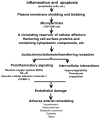Milk fat globule epidermal growth factor VIII signaling in arterial wall remodeling
- PMID: 22272902
- PMCID: PMC3398225
- DOI: 10.2174/1570161111311050014
Milk fat globule epidermal growth factor VIII signaling in arterial wall remodeling
Abstract
Arterial inflammation and remodeling, important sequellae of advancing age, are linked to the pathogenesis of age-associated arterial diseases e.g. hypertension, atherosclerosis, and metabolic disorders. Recently, high-throughput proteomic screening has identified milk fat globule epidermal growth factor VIII (MFG-E8) as a novel local biomarker for aging arterial walls. Additional studies have shown that MFG-E8 is also an element of the arterial inflammatory signaling network. The transcription, translation, and signaling levels of MFG-E8 are increased in aged, atherosclerotic, hypertensive, and diabetic arterial walls in vivo as well as activated vascular smooth muscle cells (VSMC) and a subset of macrophages in vitro. In VSMC, MFG-E8 increases proliferation and invasion as well as the secretion of inflammatory molecules. In endothelial cells (EC), MFG-E8 facilitates apoptosis. In addition, MFG-E8 has been found to be an essential component of the endothelial-derived microparticles that relay biosignals and modulate arterial wall phenotypes. This review mainly focuses upon the landscape of MFG-E8 expression and signaling in adverse arterial remodeling. Recent discoveries have suggested that MFG-E8 associated interventions are novel approaches for the retardation of the enhanced rates of VSMC proliferation and EC apoptosis that accompany arterial wall inflammation and remodeling during aging and age-associated arterial disease.
Conflict of interest statement
None.
Figures




Similar articles
-
Inflammatory Role of Milk Fat Globule-Epidermal Growth Factor VIII in Age-Associated Arterial Remodeling.J Am Heart Assoc. 2022 Sep 6;11(17):e022574. doi: 10.1161/JAHA.121.022574. Epub 2022 Aug 24. J Am Heart Assoc. 2022. PMID: 36000422 Free PMC article.
-
MFG-E8 mediates arterial aging by promoting the proinflammatory phenotype of vascular smooth muscle cells.J Biomed Sci. 2019 Aug 30;26(1):61. doi: 10.1186/s12929-019-0559-0. J Biomed Sci. 2019. PMID: 31470852 Free PMC article.
-
Milk fat globule protein epidermal growth factor-8: a pivotal relay element within the angiotensin II and monocyte chemoattractant protein-1 signaling cascade mediating vascular smooth muscle cells invasion.Circ Res. 2009 Jun 19;104(12):1337-46. doi: 10.1161/CIRCRESAHA.108.187088. Epub 2009 May 14. Circ Res. 2009. PMID: 19443842 Free PMC article.
-
Functional Role of Milk Fat Globule-Epidermal Growth Factor VIII in Macrophage-Mediated Inflammatory Responses and Inflammatory/Autoimmune Diseases.Mediators Inflamm. 2016;2016:5628486. doi: 10.1155/2016/5628486. Epub 2016 Jun 27. Mediators Inflamm. 2016. PMID: 27429513 Free PMC article. Review.
-
Roles and mechanisms of MFG-E8 in vascular aging-related diseases.Ageing Res Rev. 2020 Dec;64:101176. doi: 10.1016/j.arr.2020.101176. Epub 2020 Sep 21. Ageing Res Rev. 2020. PMID: 32971257 Review.
Cited by
-
Inflammatory Role of Milk Fat Globule-Epidermal Growth Factor VIII in Age-Associated Arterial Remodeling.J Am Heart Assoc. 2022 Sep 6;11(17):e022574. doi: 10.1161/JAHA.121.022574. Epub 2022 Aug 24. J Am Heart Assoc. 2022. PMID: 36000422 Free PMC article.
-
Proinflammation of aging central arteries: a mini-review.Gerontology. 2014;60(6):519-29. doi: 10.1159/000362548. Epub 2014 Aug 28. Gerontology. 2014. PMID: 25171100 Free PMC article. Review.
-
Proinflammation: the key to arterial aging.Trends Endocrinol Metab. 2014 Feb;25(2):72-9. doi: 10.1016/j.tem.2013.10.002. Epub 2013 Dec 20. Trends Endocrinol Metab. 2014. PMID: 24365513 Free PMC article. Review.
-
Matrix metalloproteinases promote arterial remodeling in aging, hypertension, and atherosclerosis.Hypertension. 2015 Apr;65(4):698-703. doi: 10.1161/HYPERTENSIONAHA.114.03618. Epub 2015 Feb 9. Hypertension. 2015. PMID: 25667214 Free PMC article. Review. No abstract available.
-
MFG-E8 mediates arterial aging by promoting the proinflammatory phenotype of vascular smooth muscle cells.J Biomed Sci. 2019 Aug 30;26(1):61. doi: 10.1186/s12929-019-0559-0. J Biomed Sci. 2019. PMID: 31470852 Free PMC article.
References
-
- Scuteri A, Najjar SS, Muller DC, Andres R, Hougaku H, Metter EJ, Lakatta EG. Metabolic syndrome amplifies the age-associated increases in vascular thickness and stiffness. J Am Coll Cardiol. 2004 Apr 21;43(8):1388–95. - PubMed
-
- Yoshida H, Kawane K, Koike M, Mori Y, Uchiyama Y, Nagata S. Phosphatidylserine-dependent engulfment by macrophages of nuclei from erythroid precursor cells. Nature. 2005;437:754–758. - PubMed
Publication types
MeSH terms
Substances
Grants and funding
LinkOut - more resources
Full Text Sources
Other Literature Sources
Miscellaneous

